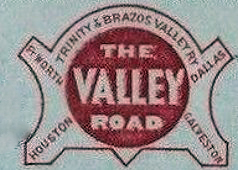
This site is non-profit and non-commercial. We are free of advertising on this site but there are costs in internet services. If you enjoy this site, we do need support.
Checks can be sent to: R. Donald Ross, 3821 Crater Lake Ct, Irving, TX 75062-4015

![]()

Don's Rail Photos

![]()
Trinity & Brazos Valley Ry.

Burlington-Rock Island RR
The T&BR was incorporated in 1902 and completed a line from Cleburne to Houston between 1903 and 1907. An additional line from Teague to Waxahachie was opened in 1907. Trackage rights to downtown Houston were over the Houston Belt & Terminal, and then to Galveston over the Galvest Houston & San Antonio. There were also trackage rights over the Missouri Kansas & Texas from Waxahachie to Dallas, and over the Santa Fe from Cleburne to Fort Worth. The road went bankrupt in 1919 and the judge cancelled all trackage rights. This left the line as the road to nowhere. The following year, trackage rights between Fort Worth and Waxahachie were permitted using the Houston & Texas Central and also to Galveston over the GH&SA. In 1930, after bankruptcy, it was reorganized as the Burlington-Rock Island RR. The road had been jointly owned since 1905 by the Burlington System's Colorado & Southern and the Chicago Rock Island & Pacific.
Under the B-RI, the line from Hillsboro to Cleburne was abandoned in 1932, and from Hillsboro to Hubbard (the original trackage of 1903) in 1935. The first streamlined train in the Southwest was the Sam Houston Zephyr on October 1, 1936, followed by The Texas Rocket on August 29, 1937. They are now long gone, and the main line is the BNSF line from Dallas to Houston.
The Handbook of Texas Online gives us the following:
TRINITY AND BRAZOS VALLEY RAILWAY. The Trinity and Brazos Valley Railway Company was chartered on October 17, 1902, to construct a railroad from some point in Johnson County in a southeastern direction to the Beaumont area. The capital stock was $300,000. Although the principal office was originally located at Hillsboro, it was moved to Cleburne and Fort Worth in 1906 and to Houston in 1908. Members of the first board of directors were S. R. Wrightington and Stephen E. Young, both of Boston, Massachusetts; Edward M. House,qv Robert H. Baker,qv and E. Sammons, all of Austin; Thomas W. Houseqv and John H. B. House, both of Houston; J. C. McDowell of Pittsburg, Pennsylvania; and William Maloneqv of San Marcos. Construction began in November 1902, and the line between Hillsboro and Mexia was opened in October 1903. The following January the section between Hillsboro and Cleburne opened for service, making a total of seventy-eight miles of track. The railroad's profits were not as high as expected, and the Eastern financiers refused to put more money into the line. At that time both the Colorado and Southern Railway Company and the Chicago, Rock Island and Pacific Railway Company were interested in expanding their respective systems from the Dallas/Fort Worth area to Houston and Galveston. Accordingly, on August 1, 1905, the Colorado and Southern bought the Trinity and Brazos Valley. Benjamin F. Yoakum,qv then chairman of the St. Louis and San Francisco Railroad Company, chairman of the Executive Committee of the Chicago, Rock Island and Pacific Railway Company, and a director of the Colorado and Southern Railway Company, contracted to complete the Trinity and Brazos Valley. Yoakum subcontracted the actual construction to the firm of P. M. Johnson and Company. Under the terms of the contract, Johnson was paid with stocks and bonds of the Trinity and Brazos Valley, with these securities subsequently purchased by the Colorado and Southern. The Colorado and Southern, in turn, sold one-half of the securities to the Rock Island. Between 1905 and 1907 an additional 224 miles were completed between Mexia and Houston and from Teague to Waxahachie. Tracks of the Missouri, Kansas and Texas Railway Company of Texas were used between Waxahachie and Dallas, while the Gulf, Colorado and Santa Fe tracks were used between Cleburne and Fort Worth and between Houston and Galveston. At Houston the Trinity and Brazos Valley acquired a one-quarter interest in the Houston Belt and Terminal then being built by Yoakum. Having been unprofitable since 1905, the Trinity and Brazos Valley entered receivership on June 16, 1914, when John W. Robins was named receiver. In 1916 it reported passenger earnings of $200,000 and freight earnings of $842,000. Robins was replaced as receiver by L. H. Atwell, Jr., who was followed by Gen. John A. Hulenqv in 1919. In 1926 the line reported passenger earnings of $170,000 and freight earnings of $2,600,000, owned thirty-seven locomotives and 1,383 cars, and was listed as a Class I railroad. The company was reorganized in 1930 as the Burlington-Rock Island Railroad Company with Hulen becoming its first president. The Trinity and Brazos Valley called itself the Valley Road, but it was more commonly known as the Boll Weevil.
Nancy Beck Young
BURLINGTON-ROCK ISLAND RAILROAD. What became the Burlington-Rock Island was chartered on October 9, 1902, as the Trinity and Brazos Valley Railway Company. By January 1904 the company had completed a line from Cleburne to Mexia, but the original backers were unable to secure financing to complete their project. The railroad was acquired by the Colorado and Southern Railway Company on August 1, 1905, with one-half interest subsequently sold to the Chicago, Rock Island and Pacific Railway Company. With the backing of two major railroads, the Trinity and Brazos Valley was completed from Mexia to Houston and from Teague to Waxahachie in 1907. Trackage rights were secured from the Missouri, Kansas and Texas Railway Company of Texas between Waxahachie and Dallas, and from the Gulf, Colorado and Santa Fe between Cleburne and Fort Worth as well as between Houston and Galveston. Chronically unprofitable, the Trinity and Brazos Valley entered receivership in 1914, with John W. Robins named receiver. Robins was replaced by L. H. Atwell, Jr., who was succeeded by Gen. John A. Hulenqv in 1919. Hulen continued as receiver until the company was reorganized as the Burlington-Rock Island on July 7, 1930. Hulen also became the first president of the Burlington-Rock Island, which took its name from the two owning systems. During the receivership General Hulen had begun upgrading the property, and the program was continued by the new company. In addition, trackage rights between Waxahachie and Dallas and between Houston and Galveston, which had been canceled in 1914, were reestablished. Trackage rights into Fort Worth, however, were no longer deemed necessary. At that time the company operated 303 miles of track. In 1931 the Burlington-Rock Island owned twenty-six locomotives, 346 freight cars, and nineteen passenger cars, and earned $64,678 in passenger revenue, $1,381,667 in freight revenue, and $43,024 in other revenue.
On June 1, 1931, the track between Teague and Waxahachie was leased jointly to the Fort Worth and Denver City and the Chicago, Rock Island and Gulf for operation as the Joint Texas Division. Management of the entire Burlington-Rock Island was turned over to the parent companies for alternating five-year periods, with the Rock Island managing until December 31, 1935. The original line between Mexia and Cleburne was abandoned in three stages. In 1932 the thirty miles of track from Cleburne to Hillsboro was abandoned; in 1935 the thirty-five miles of track from Hillsboro to Hubbard was abandoned; and in 1942 the twenty-three miles of track from Hubbard to Mexia was abandoned. On October 1, 1936, the Burlington-Rock Island inaugurated the first streamlined passenger train in Texas, the Sam Houston Zephyr, between Houston and Dallas-Fort Worth. In 1937 the line added a second streamliner, the Texas Rocket. The Rocket was replaced in January 1945 by the Twin Star Rocket, which extended streamliner service from Houston to Minneapolis-St. Paul.
A major change occurred on June 1, 1950, when the Fort Worth and Denver and the Rock Island leased the rest of the railroad from Teague to Houston to be operated as the Joint Texas Division. In April 1964 the railroad was purchased at foreclosure by the parent companies, with each company obtaining an undivided half interest in the property. The physical property was merged into the Fort Worth and Denver and the Rock Island in 1965, and the Burlington-Rock Island dissolved. The Rock Island ceased operations on March 31, 1980, leaving the Fort Worth and Denver as the sole operator of the former Burlington-Rock Island. The Fort Worth and Denver was merged into the Burlington Northern Railroad on December 31, 1982.
George C. Werner
The histories came from the The Handbook of Texas Online.
1 was built by Pittsburgh in August 1886, #818, as Pittsburgh & Western 269. It was sold thru Southern Iron & Equipment as T&BV 1.
2 was built by Pittsburgh in September 1886, #821, as P&W 272. It was sold thru SI&E as T&BV 2.
19.
31.
34.
42 was built by Alco-Richmond in 1907 #42940.
43 was built by Alco-Richmond in 1907, #42941.
44 was built by Alco-Richmond in 1907, #42942.
45 was built by Alco-Richmond in 1907, #42943,
46 was built by Alco-Richmond in 1907, #42944.
50.
51.
53 was built by Baldwin in April 1904, #24148, as St Louis Brownsville & Mexico 22. It was sold as T&BV 53.
54 was built by Baldwin in April 1904, #24163, as StLB&M 23. It was sold as T&BV 54.
55 was built by Baldwin in May 1904, #24189, as StLB&M 24. It was sold as T&BV 55.
56 was built by Baldwin in May 1904, #24195, as StLB&M 25. It was sold as T&BV 56.
75 was built by Alco-Richmond in 1907, #42928.
76 was built by Alco-Richmond in 1907, #42929.
61 thru 63 were motor cars built by Pullman in 1928 under order 6265 and powered by Electro-Motive under builder numbers 402 thru 404. They were converted to bunk cars in 1953 and scrapped in 1968 and 1969. These cars held down the "Red Head" local passenger service runs, always out of Houston, but to varying northern terminii over the years.
At Teague, the station and general offices have been preserved as a museum. Nothing has been done with the depot hotel as yet.
Streetman was about 25 miles. It was opened in 1905 but it lost population in the 1940s.
The Corsicana station appears to have had the same architect.
Nearby was Tower 184 for the Southern Pacific crossing.
The Waxahachie station followed the same pattern of the other stations.
At Cleburne there was a connection with the Atchison Topeka & Santa Fe. In this view, the T&BV station is at the far left.
Special thanks for information from Gerald Hook.
WebWork by ![]() rinity
rinity
![]() echnology Co.
echnology Co.
AMDG
10/31/2021
31st Sunday in Ordinary Time
All Hallow’s Eve
Memorial of Saint Antoninus of Milan
<><
Choose Life.
Mom did.
Don's Depot Christ Himself is our mouth through which we speak to the
Father, our eye through which we see the Father, our right hand through which we
offer to the Father. Without His intercession neither we nor all the saints have
anything with God. — St. Ambrose